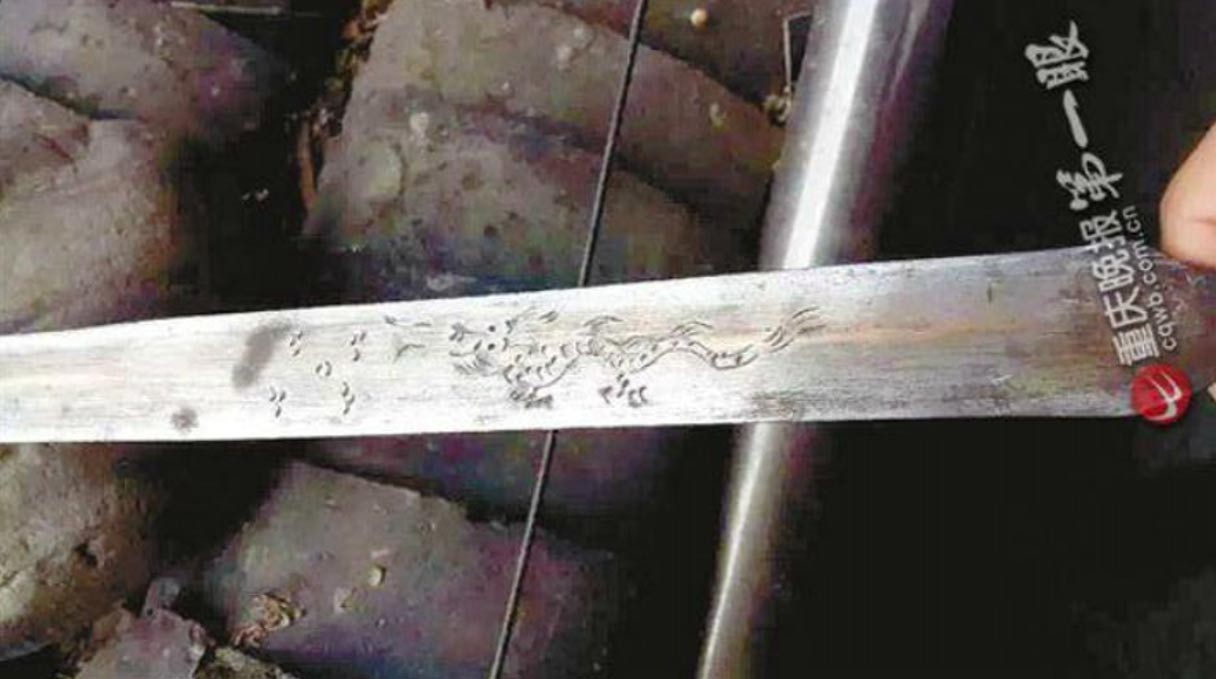Chinese man finds old sword in ground, uses it as kitchen knife
A 60-year-old Chinese farmer who found an old sword blade digging in the ground used it as a kitchen knife for several years before realizing its value and historical importance. He may have disallowed efforts to determine its exact age by polishing and sharpening it.
Experts think the sword dates to the Qing Dynasty because the characters for Qing Lang Jian, meaning Green Dragon Sword, are etched into it.
The farmer, Yi Shouxiang, found the blade minus the handle and the pointed end five years ago while digging on his land in Chengkou County, Chongqing province, says Shanghaiist.com.
Government officials became aware of the sword while visiting Yi's village in a bid to find items of historical value to put on display. The officials contacted the local cultural bureau to determine the sword's historical value.
Such swords are still used today in Tai Chi or Taijiquan training, a form of exercise and a martial art. The site White Crane Martial Arts says the double-edged straight sword, or jian, goes back 3,000 years. Before the Iron Age, jian swords were made of bronze and were shorter. But about 2,000 years ago sword makers began to use iron and steel. The length of the jian swords increased gradually.
Chai Fong Ying of Malaysia demonstrates a Tai Chi sword form in the 2010 Asian Games.
Jian blades became more refined and more popular among martial artists and martial-arts societies beginning in the Ming Dynasty of 1368-1644 and the Qing Dynasty of 1644-1912. Most antique jian swords one sees nowadays are mid to late Qing Dynasty blades. The White Crane site says excellent swords were also made in China's Republican era until 1920 or later.
In September 2014, Ancient Origins reported on the case of an 11-year-old boy washing his hands in the Laozhoulin River in Gaoyou County, China, when he felt something hard and metallic. He pulled out the object and found that it was a rusty sword—a 3,000-year-old bronze piece.
After fishing the sword out from the river, 11-year-old Yang Junxi took the relic home to his father, Yang Jinhai. As news spread around their town, locals began flocking to Yang’s home, with some offering high prices to purchase the artifact. However, Jinhai felt it was best to preserve the sword for its cultural value and sent it to the Gaoyou Cultural Relics Bureau, who rewarded the two for their honor in protecting and donating it.

A Chinese bronze sword blade similar to the one a boy found in the Laozhoulin River in 2014 (Photo c redit: Huhan Provincial Museum)
The bureau organized a team of local cultural relics experts to identify the sword. Initial identifications found that the 26cm-long (10.2-inch) bronze sword could be dated back to around the time of the Shang and Zhou dynasties, more than 3,000 years ago. It is among the oldest swords ever recovered – the first bronze swords are believed to have first been developed in China around 3,200 years ago.
Lyu Zhiwei, head of the cultural relics office of the bureau, said the bronze sword, which does not have decorative patterns, is an example of a short sword, which was often used by civil officials for decorative or status reasons. Swords of this period were typically made from bronze with high tin content for the cutting edge and bronze with low tin content for the spine, resulting in a sword with hard and durable cutting edges and a flexible spine to absorb shock. There was also extensive use of copper sulfides as anti-corrosion coatings.
Featured image: The blade appears to be double-edged straight sword, which would make. [Image via Chongqing Evening News]
By Mark Miller


















Comments
Stupid peasant, ruining a historical artifact. That's what happens when the only history you learn is what the Chinese government deems it to be. For what it's worth, 'qing long' means 'azure dragon'. It probably refers to one of the four protectors in Chinese mythology (the other 3 being the white tiger, black tortoise and red phoenix) rather than to manufacture during the Qing dynasty. The sword could therefore be a lot older than initially thought. Somewhere in the ground, there may be the white tiger counterpart to this sword. Hopefully, it will be found by someone better informed than this ignorant peasant.
Ugh. The Qing Dynasty is not "ancient." This is not an "ancient" sword. If anything, it's an early modern, or Late Imperial sword. Can we please stop throwing the word "ancient" around as if it refers to anything earlier than a century or two ago?
Now the 3000 year old blade? /That/ is an ancient sword.